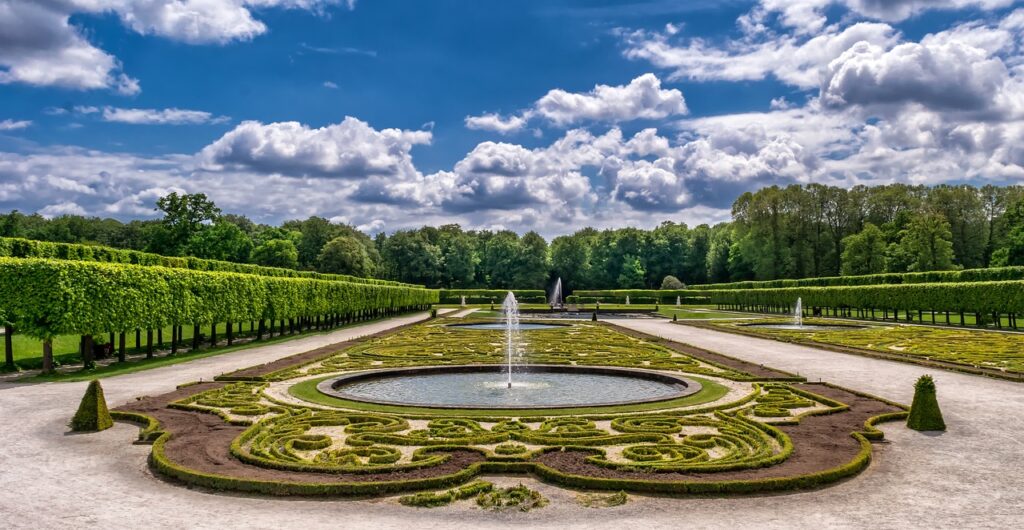If you’ve ever dreamt of transforming your small backyard into a tranquil oasis, then designing a Japanese garden might be the perfect solution. In a world where outdoor spaces are increasingly being limited by urbanization and shrinking lot sizes, creating a serene Japanese garden in a compact area can provide a sense of peace and connection to nature. From carefully chosen plantings to carefully placed stones, this article navigates the art of designing a Japanese garden in small spaces, proving that big dreams can indeed come true in even the smallest of areas.
Choosing the Right Location
When it comes to designing a Japanese garden, one of the first things you need to consider is the location. The right location will greatly contribute to the overall success and beauty of your garden. Here are a few key factors to keep in mind as you choose the perfect spot for your Japanese garden.
Consider the available space
Before you begin planning your Japanese garden, take a good look at the available space you have. Japanese gardens come in various sizes, so regardless of whether you have a small balcony or a large backyard, there is always a way to create a beautiful Japanese garden. Consider the dimensions of the space and how you can make the most of it. You may need to get creative with the layout and design to maximize the available space.
Assess the natural features of the area
Another important consideration when choosing a location for your Japanese garden is the natural features of the area. Take note of any existing trees, rocks, or water features that can be incorporated into your design. These natural elements will not only add authenticity to your Japanese garden but also provide a sense of tranquility and harmony. Working with the existing features will save you time and effort in creating a new landscape from scratch.
Decide on the orientation of the garden
The orientation of your Japanese garden is crucial to its success. Consider the direction of sunlight and wind patterns in your chosen location. This will help you determine where to place different elements within the garden, such as trees and plants. Ideally, a Japanese garden should have areas that receive both sun and shade, allowing for a variety of plants to thrive. Understanding the orientation will ensure that your garden is visually appealing and provides a comfortable environment for you to enjoy.
Understanding Japanese Garden Styles
Japanese gardens are known for their distinct styles, each with its own unique characteristics and principles. Understanding these different styles will help you choose the one that suits your space and personal preferences.
Explore the different styles of Japanese gardens
There are several traditional styles of Japanese gardens to explore. Some popular styles include the Tea Garden, Strolling Garden, and Dry Garden. Each style offers a different aesthetic and purpose, whether it’s for relaxation, meditation, or enjoying the beauty of nature. Take the time to research and visit existing Japanese gardens to get a sense of which style resonates with you.
Discover the principles behind each style
Once you have familiarized yourself with the different styles, it’s important to understand the principles that guide each one. Japanese gardens are designed with specific intentions and follow certain principles to create a harmonious and balanced environment. For example, the Tea Garden focuses on simplicity, tranquility, and the integration of water elements. Deepening your understanding of these principles will help you make informed decisions when designing your own Japanese garden.
Choose a style that suits your space
While it’s important to appreciate and respect the traditional styles and principles of Japanese gardens, it’s also essential to choose a style that suits your available space and personal preferences. If you have a small or compact area, you may opt for a simplified version of a traditional style or explore modern interpretations of Japanese garden design. Consider the scale, maintenance requirements, and overall aesthetic of each style when making your decision.

Creating Balance and Harmony
Balance and harmony are essential elements of a Japanese garden. Achieving these qualities in your design will create a peaceful and serene atmosphere that is pleasing to the eye. Here are some tips on how to create balance and harmony in your Japanese garden.
Achieve a sense of balance in your design
Balance is key in Japanese garden design. Symmetry and asymmetry are both embraced in different ways to achieve balance. You can create symmetrical balance by mirroring elements on either side of a central axis. For asymmetrical balance, focus on grouping elements based on size, shape, or color to create a sense of equilibrium. Experiment with different combinations until you find the right balance that appeals to you.
Create a harmonious blend of elements
A Japanese garden is a harmonious blend of various elements such as water, rocks, plants, and structures. Each element should complement and enhance the others to create a cohesive and visually appealing design. Pay attention to the textures, colors, and sizes of each element to ensure they work in harmony with one another. Strive for a natural and organic feel, as if each element effortlessly belongs in its place.
Use symmetry and asymmetry effectively
In Japanese garden design, symmetry and asymmetry are both utilized to create visual interest and balance. Symmetry can be achieved by placing identical or similar elements on each side of a central focal point. This creates a sense of order and tranquility. Asymmetry, on the other hand, introduces a dynamic and natural feel to the garden. Experiment with combining both symmetry and asymmetry to find a balance that suits your personal taste and the overall design of your garden.
Incorporating Key Elements
Japanese gardens are known for their use of specific elements that contribute to their unique aesthetic. When designing your own Japanese garden, consider incorporating these key elements to create an authentic and visually pleasing space.
Integrate water features like ponds or streams
Water is one of the most important elements in a Japanese garden. It symbolizes purity, tranquility, and life. Consider incorporating a pond, stream, or even a small waterfall into your design. The sound of running water can be incredibly soothing and adds a dynamic element to the garden. Place stones strategically in and around the water feature to create a natural and balanced look.
Include stone and rock formations
Another essential element in Japanese garden design is the use of stones and rocks. Stones represent stability and longevity, adding a sense of permanence to the garden. Incorporate large rocks strategically to create focal points or pathways. Use smaller rocks and pebbles to line pathways or create intricate patterns. Experiment with different sizes, shapes, and textures of rocks to add visual interest and depth to your garden.
Make use of traditional Japanese plants
the choice of plants plays a significant role in Japanese garden design. Selecting traditional Japanese plants will not only enhance the authenticity of your garden but also ensure that the plants are well-suited to the environmental conditions and maintenance requirements. Some popular traditional Japanese plants include cherry blossoms, Japanese maple trees, bamboo, and moss. Research the specific needs and characteristics of each plant to create a thriving and beautiful garden.

Designing with Paths and Bridges
Paths and bridges are not only functional but also add charm and visual interest to a Japanese garden. Carefully planning and incorporating these elements will enhance the overall design and create a sense of exploration within your garden.
Plan pathways to guide visitors
When designing paths for your Japanese garden, consider how they will guide visitors through the space. Paths should be designed to encourage a slow and contemplative pace, allowing visitors to fully immerse themselves in the beauty of the garden. Curved paths are often preferred in Japanese garden design, as they create a sense of mystery and discovery. Use materials like stepping stones, gravel, or wooden planks to create the desired path.
Incorporate bridges for a charming touch
bridges are a classic and charming feature in Japanese gardens. They not only provide a practical means of traversing over water features but also add a touch of elegance and beauty. Choose a bridge style that complements your garden’s overall aesthetic. Arched bridges are often used in traditional Japanese gardens, while modern designs may incorporate more contemporary bridge styles. Consider the size and scale of your garden when selecting a bridge to ensure it fits harmoniously within the space.
Ensure proper lighting for safety and ambiance
Proper lighting is essential for both safety and ambiance in your Japanese garden. Consider installing outdoor lighting to illuminate pathways, highlight focal points, and create a magical atmosphere. Soft and warm lighting is generally preferred in Japanese garden design, as it enhances the tranquility and natural beauty of the space. Experiment with different lighting techniques and fixtures to achieve the desired effect in your garden.
Using Plants for Privacy and Space Optimization
In addition to their aesthetic appeal, plants can serve practical purposes in a Japanese garden. When strategically chosen and placed, plants can provide privacy and maximize the use of space in your garden.
Select plants for privacy and to maximize space
If privacy is a concern in your garden, consider incorporating tall and dense plants to create natural barriers. Bamboo, evergreen trees, and shrubs can all provide privacy while adding beauty to your garden. Additionally, consider the growth habits and maintenance requirements of each plant to ensure they are suitable for your specific needs.
Utilize vertical gardening techniques
In compact areas, vertical gardening can be a great way to maximize space. Climbing plants such as wisteria or ivy can be trained to grow up trellises or structures, adding greenery and visual interest to vertical surfaces. Hanging planters or wall-mounted containers are also effective ways to introduce plants without taking up valuable ground space. Vertical gardening techniques not only optimize space but also add depth and dimension to your garden.
Create layers of plantings for depth
To create a sense of depth and visual interest in your Japanese garden, consider creating layers of plantings. Choose plants of varying heights and textures and arrange them in a way that mimics natural landscapes. For example, plant taller trees or shrubs at the back, mid-sized plants in the middle, and low-growing groundcovers or moss at the front. This layering technique will add depth to your garden and create a sense of depth and perspective.

Enhancing the Garden with Sculptures and Lanterns
Sculptures and lanterns are beautiful additions that can enhance the aesthetic and ambiance of a Japanese garden. Consider incorporating these elements to add visual interest and cultural authenticity to your outdoor space.
Add sculptures to add visual interest
Sculptures can add a unique and visually appealing touch to your Japanese garden. Traditional Japanese sculptures often depict animals, mythical creatures, or religious figures. Choose sculptures that are in line with the overall theme and aesthetic of your garden. Place them strategically, ensuring they are not overwhelming or detracting from the natural beauty of the garden. Sculptures can serve as focal points or points of interest along pathways.
Incorporate lanterns for illumination
Lanterns are not only functional but also add a touch of elegance and tradition to a Japanese garden. They provide soft and ambient lighting, enhancing the serene atmosphere of the space. Lanterns come in various styles, with stone lanterns being the most traditional and popular choice. Consider placing lanterns near pathways, entrances, or in areas that could benefit from a warm and inviting glow.
Consider traditional Japanese lantern designs
Traditional Japanese lantern designs often feature intricate and symbolic patterns. When selecting lanterns for your garden, consider these traditional designs to add authenticity and cultural significance. Choose lanterns made from natural materials such as stone or bamboo, as they blend seamlessly with the organic aesthetics of a Japanese garden. Research the symbolism behind different lantern designs to choose one that resonates with you and your garden’s overall theme.
Furnishing and Accessorizing the Space
To fully enjoy your Japanese garden, it’s essential to consider the furnishings and accessories that will enhance your outdoor experience. Choose appropriate seating options and add traditional Japanese elements to create an authentic and inviting space.
Choose appropriate seating options
Seating areas are essential in Japanese gardens, providing a place for relaxation, contemplation, and enjoyment of the surroundings. Opt for seating options that are comfortable, durable, and blend seamlessly with the overall design of your garden. Low-profile seating, such as floor cushions or wooden benches, can create an authentic and traditional atmosphere. Consider placing seating areas strategically, taking advantage of views, shade, or focal points within the garden.
Accessorize with traditional Japanese elements
Accessorizing your Japanese garden with traditional elements will add a touch of authenticity and cultural significance. Consider adding elements such as stone lanterns, bamboo screens, or shoji screens. These elements not only enhance the aesthetic appeal of your garden but also create a sense of connection to Japanese culture and tradition. Research traditional Japanese garden accessories and choose those that align with your personal taste and the overall theme of your garden.
Consider adding a tea house or gazebo
For those who want to take their Japanese garden to the next level, consider adding a tea house or gazebo. These structures provide a dedicated space for tea ceremonies, meditation, or simply relaxing and enjoying the garden. Tea houses are traditionally designed with sliding doors, tatami mats, and a minimalist aesthetic. Gazebos offer a covered outdoor space for seating or gatherings. Depending on the size of your garden, choose the structure that best suits your needs and budget.
Maintaining and Caring for a Japanese Garden
Once you have created your Japanese garden, it’s important to understand the maintenance requirements to ensure its longevity and beauty. Here are some essential tips for caring for your Japanese garden.
Learn about the specific maintenance requirements
Different elements within a Japanese garden require specific maintenance to thrive and remain healthy. Research the maintenance requirements of each plant, tree, or other features in your garden. This includes understanding their water needs, pruning requirements, and fertilization schedules. Regular cleaning and removal of debris are also essential to keep your garden looking tidy and inviting.
Understand the importance of pruning and trimming
Pruning and trimming are essential practices in Japanese garden maintenance. They help maintain the desired shape, size, and aesthetics of trees, shrubs, and other plants. Proper pruning techniques should be followed to prevent damage and promote healthy growth. Regular trimming also prevents overcrowding and maintains the balance and harmony of the garden. Consider seeking professional guidance or learning proper pruning techniques to ensure you are caring for your garden correctly.
Ensure proper irrigation and drainage
Proper irrigation and drainage are crucial for the health of your Japanese garden. Different plants and elements may require specific watering schedules or techniques. Consider installing a proper irrigation system to ensure each plant receives the appropriate amount of water. Additionally, ensure that your garden has proper drainage to prevent waterlogged soil or standing water, which can lead to root rot or other issues. Regularly monitor and adjust your watering practices to meet the changing needs of your garden.
Seeking Inspiration and Professional Guidance
Designing and maintaining a Japanese garden can be a rewarding yet challenging endeavor. If you find yourself in need of inspiration or professional guidance, there are resources available to assist you.
Gather inspiration from existing Japanese gardens
Visiting existing Japanese gardens can provide inspiration and ideas for your own design. Take note of the different styles, elements, and techniques used in these gardens. Pay attention to the sense of tranquility, balance, and harmony they evoke. Visit public Japanese gardens, botanical gardens, or even private residences that showcase Japanese garden designs. Take photographs, sketch ideas, and apply what you’ve observed to your own space.
Consult with professional garden designers
If you feel overwhelmed or unsure about designing your own Japanese garden, consider consulting with professional garden designers. They have the knowledge and experience to guide you through the design process, offer suggestions, and help you create a garden that suits your space and personal aesthetic. A professional designer can help you navigate through technical aspects such as irrigation systems, plant selection, and hardscape installation. Their expertise will ensure that your Japanese garden is not only visually appealing but also functional and sustainable.
Attend workshops or gardening classes
To deepen your understanding of Japanese garden design and maintenance, consider attending workshops or gardening classes. Many organizations, botanical gardens, and universities offer courses specifically focused on Japanese garden design and maintenance. These classes provide hands-on experience, expert advice, and an opportunity to connect with other like-minded individuals. Engaging in ongoing learning and professional development will not only enhance your skills but also inspire new ideas and approaches in your own garden.
In conclusion, designing a Japanese garden in a compact area is an exciting venture that can transform your outdoor space into a serene and beautiful sanctuary. By considering the available space, understanding different Japanese garden styles, creating balance and harmony, incorporating key elements, designing with paths and bridges, utilizing plants for privacy and space optimization, enhancing the garden with sculptures and lanterns, furnishing and accessorizing the space, and maintaining the garden properly, you can create a Japanese garden that brings joy and tranquility to your life. Seek inspiration, professional guidance, and continue learning to refine your skills and create a truly remarkable Japanese garden.








